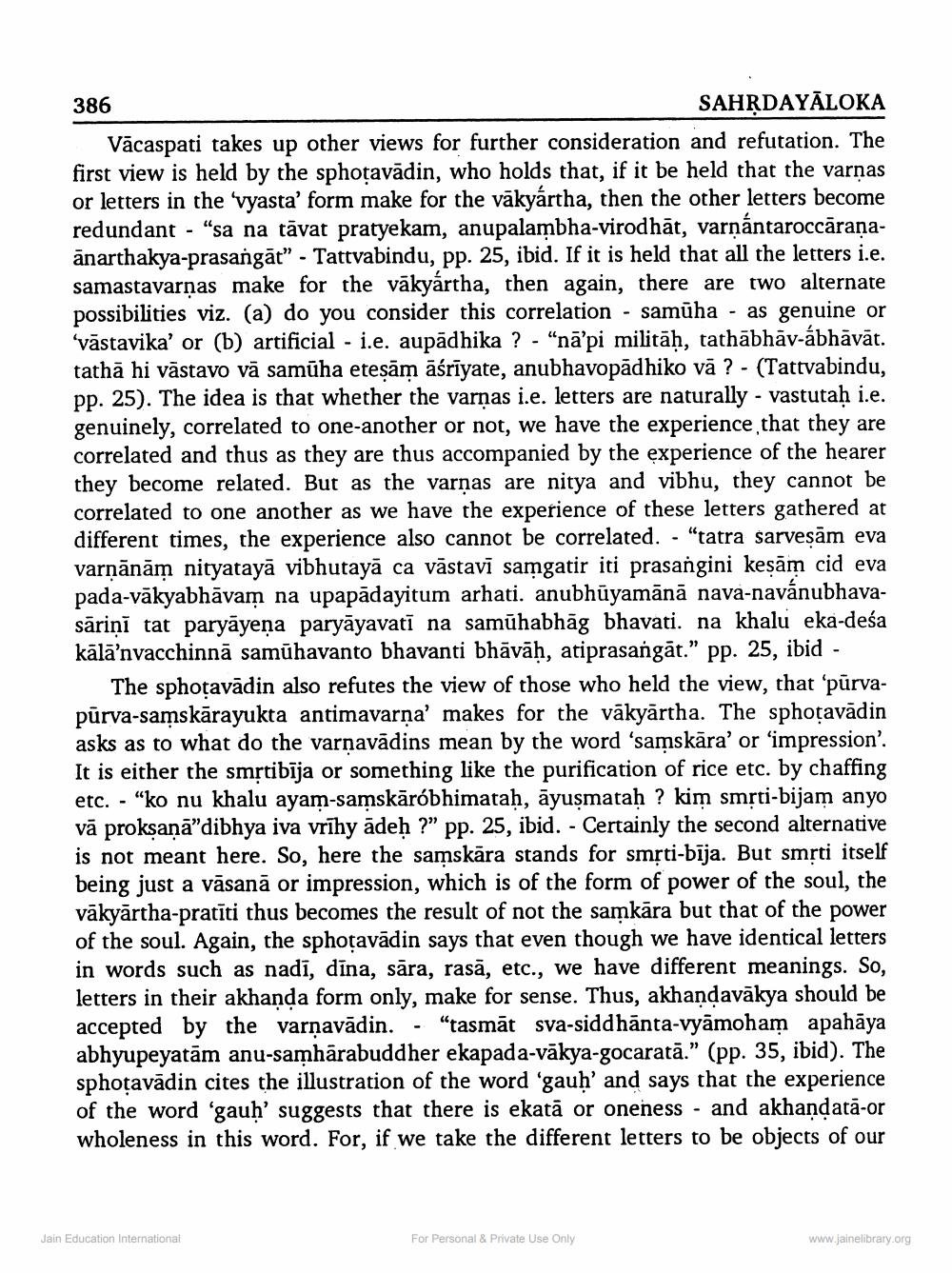________________
386
SAHRDAYĀLOKA Vācaspati takes up other views for further consideration and refutation. The first view is held by the sphotavādin, who holds that, if it be held that the varnas or letters in the 'vyasta' form make for the vākyártha, then the other letters become redundant - "sa na tāvat pratyekam, anupalambha-virodhāt, varnántaroccāranaanarthakya-prasangāt" - Tattvabindu, pp. 25, ibid. If it is held that all the letters i.e. samastavarņas make for the vākyártha, then again, there are two alternate possibilities viz. (a) do you consider this correlation - samüha - as genuine or vāstavika' or (b) artificial - i.e. aupādhika ? - "nā’pi militāh, tathābhāv-ábhāvāt. tathā hi vāstavo vā samūha etesām āśrīyate, anubhavopādhiko vā ?- (Tattvabindu, pp. 25). The idea is that whether the varņas i.e. letters are naturally - vastutaḥ i.e. genuinely, correlated to one another or not, we have the experience that they are correlated and thus as they are thus accompanied by the experience of the hearer they become related. But as the varnas are nitya and vibhu, they cannot be correlated to one another as we have the experience of these letters gathered at different times, the experience also cannot be correlated. - "tatra sarvesām eva varnānām nityatayā vibhutayā ca vāstavī samgatir iti prasangini keşām cid eva pada-vākyabhāvam na upapādayitum arhati. anubhūyamānā nava-navānubhavasārini tat paryāyena paryāyavati na samūhabhāg bhavati. na khalu eka-deśa kālā’nvacchinnā samūhavanto bhavanti bhāvāḥ, atiprasangāt.” pp. 25, ibid -
The sphotavādin also refutes the view of those who held the view, that 'pūrvapūrva-samskārayukta antimavarna' makes for the vākyārtha. The sphoțavādin asks as to what do the varnavādins mean by the word 'samskāra' or 'impression'. It is either the smrtibīja or something like the purification of rice etc. by chaffing etc. - “ko nu khalu ayam-samskāróbhimataḥ, āyuşmatah ? kim smrti-bijam anyo vā prokşaņā"dibhya iva vrīhy ādeh ?” pp. 25, ibid. - Certainly the second alternative is not meant here. So, here the samskāra stands for smộti-bīja. But smrti itself being just a vāsanā or impression, which is of the form of power of the soul, the vākyārtha-pratīti thus becomes the result of not the samkāra but that of the power of the soul. Again, the sphoțavādin says that even though we have identical letters in words such as nadi, dīna, sāra, rasā, etc., we have different meanings. So, letters in their akhanda form only, make for sense. Thus, akhandavākya should be accepted by the varņavādin. - "tasmāt sva-siddhānta-vyāmoham apahāya abhyupeyatām anu-samhārabuddher ekapada-vākya-gocaratā.” (pp. 35, ibid). The sphotavādin cites the illustration of the word 'gauh' and says that the experience of the word 'gauh' suggests that there is ekatā or oneness - and akhandatā-or wholeness in this word. For, if we take the different letters to be objects of our
Jain Education International
For Personal & Private Use Only
www.jainelibrary.org




